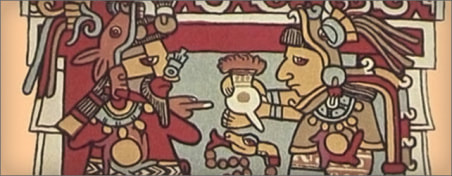
When I think of hot chocolate, I think of mugs of warm, sweet comfort. I lived in Massachusetts for three years in my childhood and have many memories of sledding until my fingers and toes burned with cold, then rushing home to cocoa in a steamy kitchen. I also think of a warm chair by the fire, and curling up with a good book.
But hot chocolate didn’t originate in the frozen north, and its history has more to do with diplomacy than comfort.
 Still from a YouTube video on cacao production.
Still from a YouTube video on cacao production.Chocolate is made from the fruit of cacao trees. These small trees are native to Central and South America. They produce fruits, called pods, that are roughly the size of a person’s hand and are shaped like footballs. Within their tangy-sweet, gummy white flesh, each pod contains around 40 cacao beans that are bitter in taste and nothing like the chocolate we know and love.
It appears that the ancient Olmecs of southern Mexico were the first to dry and roast cocoa beans. Because they kept no written history, it’s hard to know exactly where, when, or why the Olmecs began processing cacao beans, but pots and vessels dating back to around 1500 B.C. have traces of theobromine, a stimulant compound found in chocolate. Archeologists believe that early recipes were for drinks or gruels that were likely very bitter and used for ceremony rather than pleasure.
After the Olmecs, the Mayans continued to use chocolate. Fortunately for historians, the Mayans kept written records, and through them we know that Mayan chocolate was thick and frothy. It often included chili peppers and honey. We know that cacao drinks were commonly drunk in everyday situations, and became part of the Mayan identity like wine is to the French, coffee to the Arab world, or craft beer to many locations today. Records indicate that many Mayan households drank chocolate with every meal.
But cacao wasn’t just a drink. Mayan written history indicates that chocolate drinks were incorporated into religious ceremonies, were used in celebrations, and helped finalize important transactions. These beverages were part of initiation rites for young men and celebrations marking the end of the Maya calendar year. In the early 12th century, chocolate was part of the dowry used to seal the marriage of a Mixtec ruler in the sacred Valley of Oaxaca.
The Aztecs continued the love of cacao beans, which they considered more valuable than gold. Although it’s likely that Spanish historians have exaggerated, they claimed that Montezuma drank fifty cups of chocolate each day, both for the energy it gave him, and as an aphrodisiac. It’s likely that Spanish conquistador Hernan Cortes was introduced to chocolate by Montezuma and in turn introduced it to the Spanish court of Philip II of Spain in 1544.
After the Olmecs, the Mayans continued to use chocolate. Fortunately for historians, the Mayans kept written records, and through them we know that Mayan chocolate was thick and frothy. It often included chili peppers and honey. We know that cacao drinks were commonly drunk in everyday situations, and became part of the Mayan identity like wine is to the French, coffee to the Arab world, or craft beer to many locations today. Records indicate that many Mayan households drank chocolate with every meal.
But cacao wasn’t just a drink. Mayan written history indicates that chocolate drinks were incorporated into religious ceremonies, were used in celebrations, and helped finalize important transactions. These beverages were part of initiation rites for young men and celebrations marking the end of the Maya calendar year. In the early 12th century, chocolate was part of the dowry used to seal the marriage of a Mixtec ruler in the sacred Valley of Oaxaca.
The Aztecs continued the love of cacao beans, which they considered more valuable than gold. Although it’s likely that Spanish historians have exaggerated, they claimed that Montezuma drank fifty cups of chocolate each day, both for the energy it gave him, and as an aphrodisiac. It’s likely that Spanish conquistador Hernan Cortes was introduced to chocolate by Montezuma and in turn introduced it to the Spanish court of Philip II of Spain in 1544.





No comments:
Post a Comment